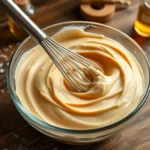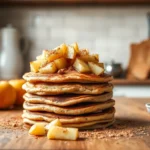Crispy, buttery, and absolutely irresistible – we’re talking about homemade Biscoff butter cookies that’ll transform your kitchen into a European bakery. These golden beauties pack all the caramelized spiced goodness of the beloved Belgian cookies we know and love, but with that extra tender crumb that only comes from making them fresh at home.
What makes these cookies so special? It’s the perfect marriage of rich butter and warm spices like cinnamon and cardamom that creates that signature Biscoff flavor we can’t get enough of. The secret lies in achieving that ideal balance between crispy edges and a slightly chewy center.
Ingredients
Creating these delectable Biscoff butter cookies requires simple pantry staples combined with a few specialty ingredients that deliver authentic European flavor. We’ve organized our ingredient list into two sections to help you prepare both the cookie base and the signature Biscoff filling.
For the Cookies
- 2 1/4 cups all-purpose flour
- 1 cup unsalted butter, softened to room temperature
- 3/4 cup packed light brown sugar
- 1/2 cup granulated sugar
- 1 large egg, at room temperature
- 1 teaspoon vanilla extract
- 1 teaspoon ground cinnamon
- 1/2 teaspoon ground cardamom
- 1/2 teaspoon ground ginger
- 1/4 teaspoon ground nutmeg
- 1/2 teaspoon baking soda
- 1/2 teaspoon salt
- 2 tablespoons whole milk
For the Biscoff Filling
- 1/2 cup Biscoff cookie butter, smooth variety
- 2 tablespoons unsalted butter, softened
- 1/4 cup powdered sugar, sifted
- 1 tablespoon heavy cream
- 1/4 teaspoon vanilla extract
- Pinch of salt
Equipment Needed
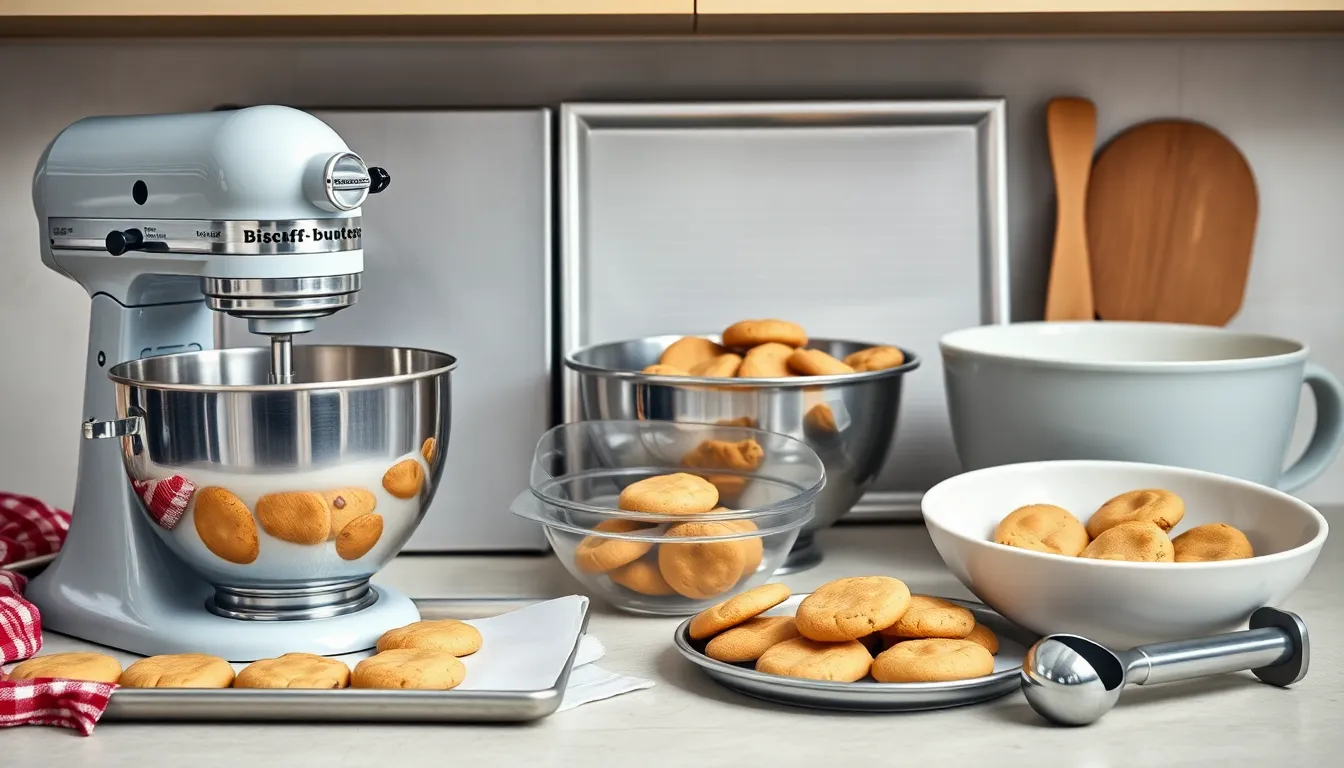
Creating perfect Biscoff butter cookies requires the right tools to achieve that signature crispy texture and uniform baking results. We recommend gathering these essential pieces of equipment before starting your cookie-making journey.
Baking sheets form the foundation of successful cookie baking. We suggest using at least two heavy-duty baking sheets to allow for continuous baking while one batch cools. Light-colored aluminum sheets work best as they promote even browning without over-darkening the cookie bottoms.
Hand mixer or electric mixer ensures proper creaming of butter and sugars. We find that a stand mixer works exceptionally well for incorporating the Biscoff spread smoothly into the butter mixture. The consistent mixing action creates the light and fluffy texture that makes these cookies irresistible.
Medium and large mixing bowls keep your ingredients organized throughout the process. We use the medium bowl for combining dry ingredients like flour, baking powder, baking soda, and salt. The large bowl accommodates the creamed butter mixture and provides ample space for folding in the dry ingredients without creating a mess.
Spatula becomes essential for scraping down bowl sides and ensuring complete ingredient incorporation. We prefer a flexible silicone spatula that reaches into every corner of the mixing bowl. This tool also helps fold in any optional additions like chocolate chips or chopped Biscoff cookies without overmixing the dough.
Cookie scoop (medium size) guarantees uniform cookie sizes and consistent baking times. We recommend a medium-sized scoop that creates cookies approximately 2 inches in diameter. This tool eliminates guesswork and ensures each cookie bakes evenly to achieve those perfectly golden edges that make Biscoff butter cookies so appealing.
Instructions
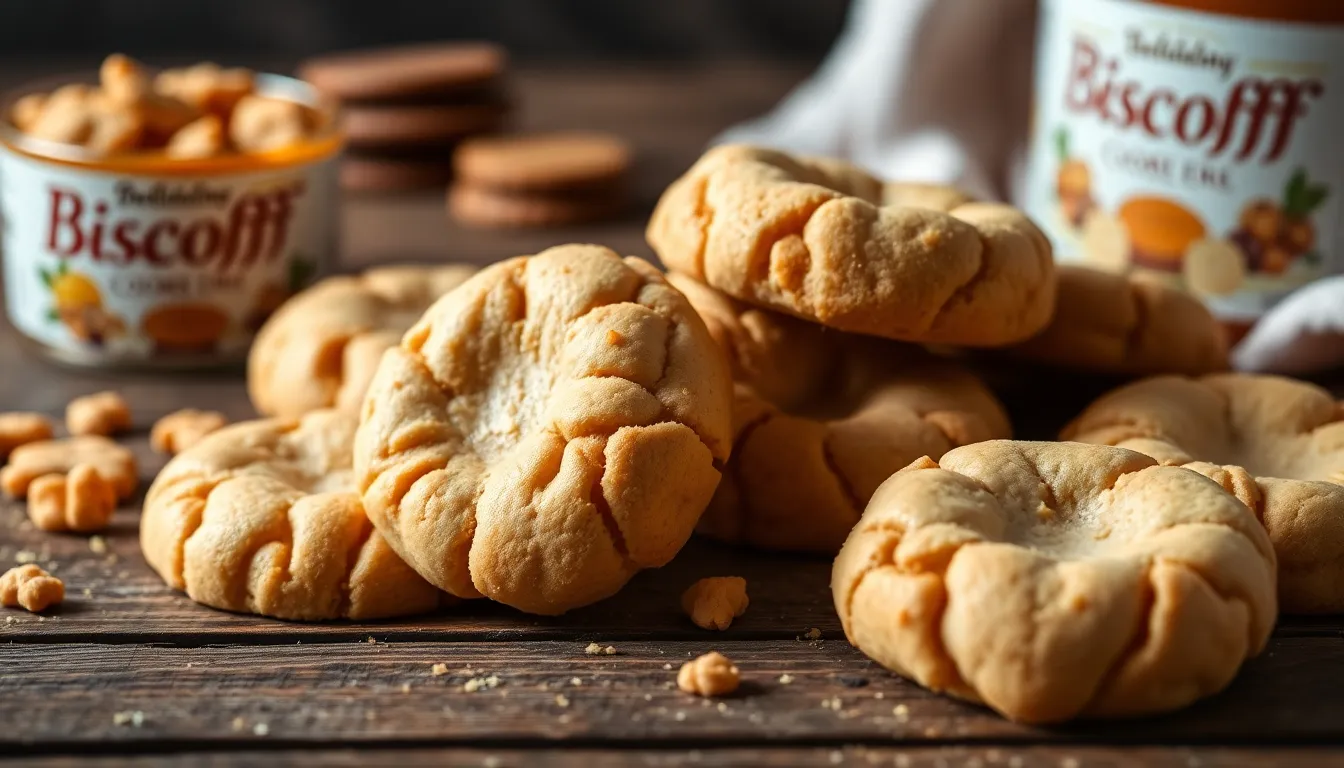
Let’s walk through each step to create these irresistible Biscoff butter cookies with their signature crispy edges and buttery centers. We’ll guide you through the complete process from mixing the dough to assembling the final sandwich cookies.
Prep the Cookie Dough
Start by combining all-purpose flour, baking soda, salt, cinnamon, and cardamom in a medium mixing bowl. Whisk these dry ingredients together until evenly distributed. In your large mixing bowl, cream the unsalted butter and Biscoff cookie butter spread using your hand or stand mixer on medium speed for 2-3 minutes. Add both granulated and brown sugars to the butter mixture and continue creaming for another 2 minutes until light and fluffy.
Beat in the egg and vanilla extract until fully incorporated. Gradually add the dry ingredient mixture to the wet ingredients, mixing on low speed until just combined. Avoid overmixing to maintain the tender cookie texture we’re aiming for.
Shape and Chill the Cookies
Using your medium-sized cookie scoop, portion the dough into uniform balls approximately 1.5 inches in diameter. Place the dough balls on a parchment-lined baking sheet, spacing them about 2 inches apart. For better shape retention during baking, transfer the shaped cookies to the freezer for 15-20 minutes. This chilling step helps prevent excessive spreading and maintains the cookies’ structure.
Bake the Cookies
Preheat your oven to 350°F (175°C) while the cookies chill. Remove the cookies from the freezer and place them directly onto your heavy-duty baking sheets. Bake for 10-12 minutes until the edges turn lightly golden brown. The centers should still appear slightly soft when you remove them from the oven.
Allow the cookies to cool on the baking sheet for 5 minutes before transferring to a wire rack. This cooling period prevents breaking and allows the cookies to finish setting properly.
Make the Biscoff Filling
Warm the Biscoff cookie butter spread in the microwave for 30 seconds to make it easier to work with. In a medium bowl, combine the warmed Biscoff spread with softened butter using your mixer on medium speed. Gradually add powdered sugar and beat until smooth and creamy. Add heavy cream one tablespoon at a time until you achieve a spreadable consistency that holds its shape.
Assemble the Sandwich Cookies
Select cookies of similar sizes to create even sandwich pairs. Spread approximately 1 tablespoon of the Biscoff filling onto the flat side of one cookie using your silicone spatula. Gently press another cookie on top, flat side down, creating a sandwich. For extra visual appeal, roll the edges of the assembled cookies in crumbled Biscoff cookies or drizzle additional warmed Biscoff spread on top.
Store the finished sandwich cookies in an airtight container where they’ll maintain their texture for up to one week.
Directions for Storage

Proper storage techniques will keep our Biscoff butter cookies fresh and maintain their signature crispy texture for maximum enjoyment. We recommend several storage methods based on when you plan to enjoy these delightful treats.
Room Temperature Storage
Store finished cookies in an airtight container at room temperature for optimal freshness. Our cookies maintain their perfect texture and flavor for up to 5 days when stored this way. We ensure the container seals completely to prevent air exposure that can make the cookies lose their crispiness.
Freezing Baked Cookies
Freeze completed cookies in ziplock bags for extended storage lasting 2 to 3 months. We place parchment paper between cookie layers to prevent sticking and maintain their delicate structure. This method works exceptionally well for batch preparation when we want to enjoy fresh cookies over several weeks.
Freezing Cookie Dough
We can prepare cookie dough ahead using this convenient freezing technique. Scoop the cookie dough into portions and top each with extra Biscoff spread before placing on a baking tray. Freeze the dough balls solid on the tray then transfer them to an airtight container for storage up to 2 weeks.
Bake frozen dough balls directly from the freezer by adding 2 to 3 minutes to the original baking time. We allow refrigerated dough to come to room temperature before baking to ensure proper spreading in the oven.
Make Ahead Options
| Storage Method | Duration | Temperature |
|---|---|---|
| Room temperature (airtight container) | 2-5 days | Room temperature |
| Refrigerated dough | 3 days | Refrigerator |
| Frozen dough | 2 weeks | Freezer |
| Frozen baked cookies | 2-3 months | Freezer |
Store unbaked dough in the refrigerator for up to three days when we want to prepare fresh cookies within a few days. We wrap the dough tightly in plastic wrap to prevent it from absorbing refrigerator odors and maintain its rich Biscoff flavor profile.
Make-Ahead Tips

We can prepare these delicious Biscoff butter cookies well in advance to save time and enjoy fresh cookies whenever cravings strike. Planning ahead allows us to maintain the perfect texture and flavor that makes these cookies irresistible.
Preparing Cookie Dough in Advance
Our Biscoff butter cookie dough keeps beautifully when prepared ahead of time. We can store the prepared dough in the refrigerator for up to 3 days when tightly covered or placed in an airtight container. This short-term storage method works perfectly for weekend baking or when we want fresh cookies within a few days.
For longer storage needs, we recommend freezing the shaped dough balls for maximum convenience. Using a cookie scoop or spoon, we portion the dough into individual servings and roll them into balls. We then place these dough balls on a tray and freeze them until solid before transferring to a freezer bag for storage.
| Storage Method | Duration | Temperature |
|---|---|---|
| Refrigerated dough | Up to 3 days | 35-40°F |
| Frozen dough balls | Up to 3 months | 0°F |
When we’re ready to bake frozen dough, we can place the frozen balls directly on our baking sheets without thawing. We simply add a few extra minutes to the baking time to account for the frozen temperature. This method ensures we always have fresh cookie dough ready for baking at a moment’s notice.
Storing Baked Cookies
Once our Biscoff butter cookies are baked and completely cooled, proper storage maintains their signature crispy texture and prevents sogginess. We store the finished cookies in an airtight container at room temperature where they stay fresh for up to 5 days.
Temperature control proves crucial for maintaining optimal texture. We never stack cookies before they reach complete room temperature as this creates condensation that makes them soggy. When our cookies feature melted Biscoff spread toppings, we allow the topping to set completely before storing to prevent sticking and maintain the best texture.
We add any toppings such as Biscoff cookie crumbs or additional spread immediately after baking while the cookies are still warm. This timing prevents the toppings from softening the cookies during storage and preserves the delightful contrast between crispy cookie and creamy topping.
Serving Suggestions

We love how versatile Biscoff butter cookies become once they leave the baking sheet. These caramelized, cinnamon-spiced treats shine brightest when paired with your favorite hot beverages, particularly coffee or tea where their crisp texture enhances the traditional European café experience.
Classic Pairings
Dipping our freshly baked cookies into steaming coffee or tea creates the perfect balance of warmth and crunch. The cookies absorb just enough liquid to soften slightly while maintaining their signature texture. We recommend serving them alongside espresso or chai tea to complement their warm spice profile.
Creative Dessert Applications
Transform your Biscoff butter cookies into show-stopping desserts by crushing them into fine crumbs for cheesecake crusts or pie bases. We often layer crushed cookies with yogurt and fresh fruit to create elegant parfaits that work beautifully for breakfast or dessert presentations.
Crumbling our cookies over vanilla or caramel ice cream adds delightful texture contrast and intensifies the caramelized flavor profile. The combination creates an indulgent treat that rivals any restaurant dessert.
Sandwich Cookie Variations
We love creating decadent sandwich cookies by filling two of our Biscoff butter cookies with Biscoff cookie butter or chocolate spread. This technique doubles the flavor impact and creates an impressive presentation for special occasions.
Breakfast and Beverage Enhancements
Stirring crushed Biscoff butter cookies into hot chocolate or coffee transforms ordinary beverages into café-quality drinks with creamy, spiced notes. We also recommend spreading Biscoff cookie butter on toast, pancakes, or waffles for a sweet breakfast option that incorporates our homemade cookies.
Advanced Dessert Techniques
Our cookies work exceptionally well in layered desserts such as tiramisu, where coffee-soaked Biscoff cookies pair with mascarpone cream. We suggest chilling these complex desserts overnight for optimal texture and flavor infusion.
Mix crushed cookies into frostings or whipped cream for cakes and cupcakes to add both flavor and visual appeal to your baked goods.
| Serving Method | Best Pairing | Texture Result |
|---|---|---|
| Coffee/Tea Dipping | Espresso or Chai | Slightly softened with maintained crunch |
| Ice Cream Topping | Vanilla or Caramel | Crispy contrast to smooth ice cream |
| Parfait Layers | Greek Yogurt and Berries | Textural variety in each spoonful |
| Sandwich Filling | Cookie Butter or Chocolate | Rich, indulgent bite |
Troubleshooting Tips

Even with careful preparation our Biscoff butter cookies can sometimes present challenges that affect their final texture and appearance. We’ve identified the most common issues bakers encounter and provide proven answers to ensure your cookies turn out perfectly every time.
Cookie Texture Issues
Dry or Crumbly Cookies
Using a kitchen scale prevents over-measuring flour which frequently causes dry or crumbly textures. We recommend weighing ingredients rather than using measuring cups for accuracy. Overmixing the dough creates tough cookies so we mix only until ingredients are just combined.
Cookies Not Spreading
Check that you’ve used enough butter and ensure the dough isn’t too cold before baking. Room temperature dough spreads more evenly during baking. We let chilled dough sit for 5-10 minutes at room temperature if it feels too firm.
Hard or Overbaked Cookies
Remove cookies from the oven once edges turn golden brown for soft and chewy texture. Overbaking leads to crispier cookies which may not match your desired texture. Baking time varies by oven so we monitor cookies for visual cues rather than relying strictly on timer settings.
| Issue | Cause | Solution |
|---|---|---|
| Dry/Crumbly | Over-measuring flour | Use kitchen scale for accuracy |
| Tough texture | Overmixing dough | Mix until just combined |
| Not spreading | Too much flour or cold dough | Check measurements and dough temperature |
| Hard cookies | Overbaking | Remove when edges are golden brown |
Filling Consistency Problems
Melting Filling During Baking
For cookies with cookie butter centers the filling must remain firm enough to maintain shape during baking. We achieve this by freezing scoops of Biscoff spread for 20-30 minutes before incorporating them into the dough. Ensure your oven temperature is accurate as excessive heat causes filling to melt too quickly.
Chunky Texture Issues
When crushing whole Biscoff cookies for added texture aim for chunks approximately 1/2 inch in size. Pieces that are too large create uneven textures while overly fine crumbs don’t provide the desired contrast. We use a rolling pin to achieve consistent chunk sizes.
Enhanced Flavor Technique
Stuff cookies with extra cookie butter by freezing small scoops and embedding them in the dough before baking. This creates pockets of concentrated Biscoff flavor throughout each cookie. The frozen filling maintains its shape better during the baking process.
Variations and Substitutions
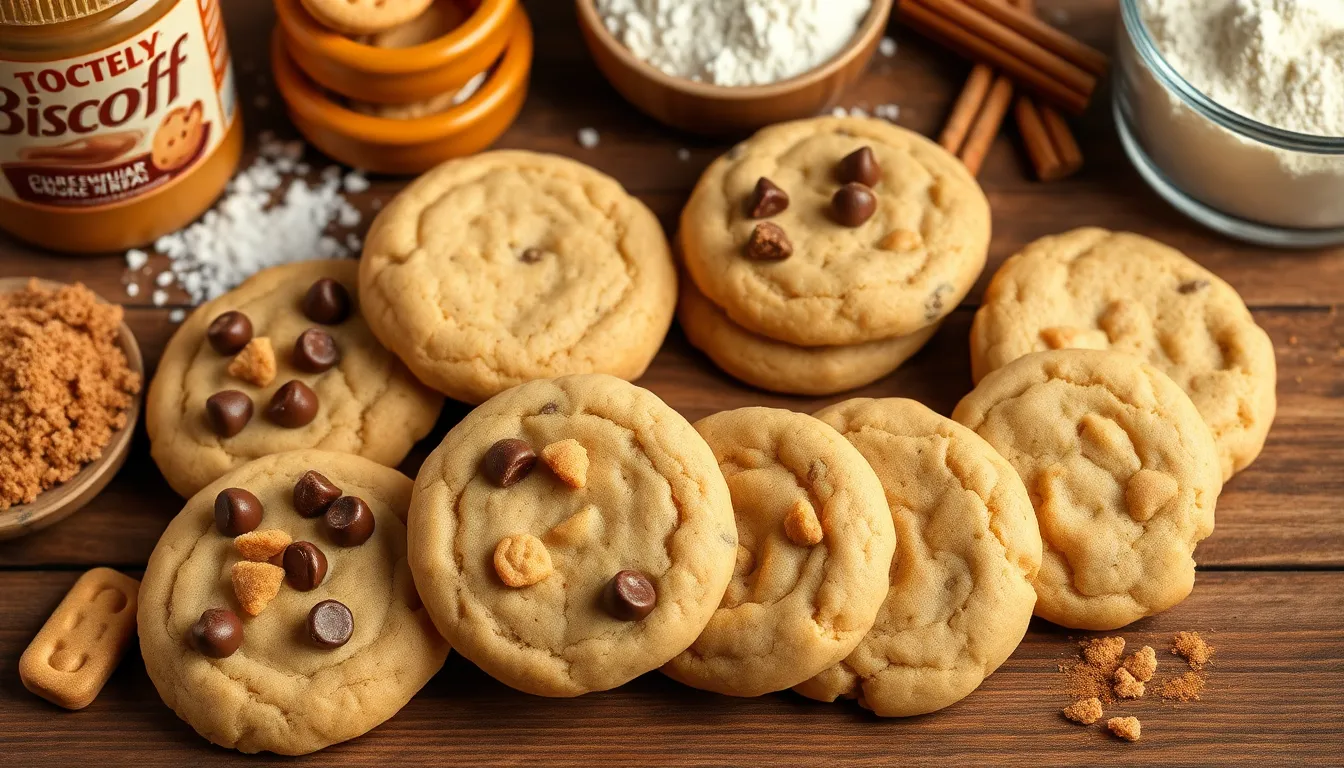
We can customize these Biscoff butter cookies to match your preferences through simple ingredient swaps and creative additions. Our testing shows that several substitutions maintain the signature cinnamon caramel flavor while accommodating different dietary needs and taste preferences.
Cookie Spread Alternatives
Speculoos Cookie Butter serves as an excellent substitute for Biscoff spread in our recipe. Trader Joe’s Speculoos Spread delivers nearly identical results with the same warm spice profile. Both alternatives provide the characteristic caramel notes that make these cookies irresistible.
Butter Modifications
American unsalted butter works best in our recipe to prevent excessive spreading during baking. We recommend using salted butter only if you reduce the additional salt by half to maintain proper flavor balance. European-style butter with higher fat content creates richer cookies but may require slight flour adjustments.
Sugar Variations
Light brown sugar creates our standard sweetness level while dark brown sugar intensifies the caramel flavor for deeper complexity. We suggest using dark brown sugar when you want cookies with more pronounced molasses notes. Coconut sugar substitutes well for a slightly less sweet alternative with subtle caramel undertones.
Flour Options
All-purpose flour remains our go-to choice for consistent texture and structure. Whole wheat pastry flour can replace up to half the all-purpose flour for added nuttiness without compromising texture. Gluten-free flour blends work effectively but may require an additional egg yolk for binding.
Mix-In Additions
Chocolate chips transform these cookies into decadent treats. We prefer semisweet chocolate chips for balanced sweetness or white chocolate chips for extra richness. Crushed Biscoff cookies add delightful texture contrast and amplify the signature flavor.
Spice Enhancements
Cinnamon and nutmeg complement the existing Biscoff flavors beautifully. We add ½ teaspoon ground cinnamon for warmth or ¼ teaspoon nutmeg for subtle complexity. Cardamom provides an exotic twist that pairs exceptionally well with the cookie butter base.
Texture Modifications
| Texture Goal | Adjustment | Result |
|---|---|---|
| Thin and crispy | Reduce flour by 2 tablespoons | Spreads more during baking |
| Thick and chewy | Add extra egg yolk + chill dough 30 minutes | Creates bakery-style thickness |
| Extra soft | Replace 2 tablespoons flour with cornstarch | Tender, cake-like texture |
Preparation Variations
No-chill dough preparation allows immediate baking when time is limited. Chilled dough for 30 minutes creates thicker cookies with less spreading. We recommend the chilled method for perfectly shaped cookies with defined edges.
Conclusion
These homemade Biscoff butter cookies bring the magic of European bakeries straight to your kitchen. With their perfect balance of crispy edges and tender centers they’ll quickly become a household favorite that rivals any store-bought version.
The beauty of this recipe lies in its versatility and make-ahead convenience. Whether you’re serving them at a dinner party pairing them with your morning coffee or gifting them to loved ones these cookies deliver consistent results every time.
We’ve equipped you with everything needed to master these delightful treats – from essential techniques to creative variations that suit any dietary preference. Your journey to cookie perfection starts with that first golden batch fresh from your oven.
Frequently Asked Questions
What makes Biscoff butter cookies different from regular butter cookies?
Biscoff butter cookies feature a unique combination of rich butter and warm spices like cinnamon and cardamom, creating the signature Biscoff taste. They’re often made with Biscoff cookie butter filling, giving them a distinctive European bakery flavor that’s more complex than traditional butter cookies.
How long do homemade Biscoff butter cookies stay fresh?
When stored properly in an airtight container at room temperature, Biscoff butter cookies stay fresh for up to 5 days. For longer storage, you can freeze baked cookies for 2-3 months in ziplock bags with parchment paper between layers.
Can I make Biscoff cookie dough ahead of time?
Yes! Cookie dough can be refrigerated for up to 3 days or frozen as shaped balls for up to 3 months. When baking frozen dough, place directly on baking sheets and add a few extra minutes to the baking time.
What equipment do I need to make perfect Biscoff butter cookies?
Essential equipment includes heavy-duty baking sheets for even browning, a hand or stand mixer for creaming ingredients, mixing bowls, a flexible silicone spatula, and a medium-sized cookie scoop for uniform sizing and consistent baking results.
Why are my Biscoff cookies turning out dry or crumbly?
Dry or crumbly cookies usually result from too much flour or overbaking. Use a kitchen scale for accurate measurements, avoid overmixing the dough, and monitor baking times closely. Remove cookies when edges are golden but centers still look slightly underbaked.
What’s the best way to serve Biscoff butter cookies?
These cookies pair perfectly with hot beverages like coffee, espresso, or chai tea for a traditional European café experience. They can also be used in desserts as cheesecake crusts, ice cream toppings, or made into sandwich cookies with additional Biscoff spread.
Can I substitute ingredients in Biscoff butter cookies?
Yes! You can substitute different cookie spreads, use various butter alternatives, try different sugar types, or add mix-ins like chocolate chips. For dietary needs, consider gluten-free flour or dairy-free butter while maintaining the signature spice blend.
How do I prevent my Biscoff cookies from not spreading during baking?
Ensure your butter is properly softened to room temperature before creaming. Cold butter won’t spread properly. Also, don’t over-chill the dough, and make sure your oven is fully preheated before baking.


